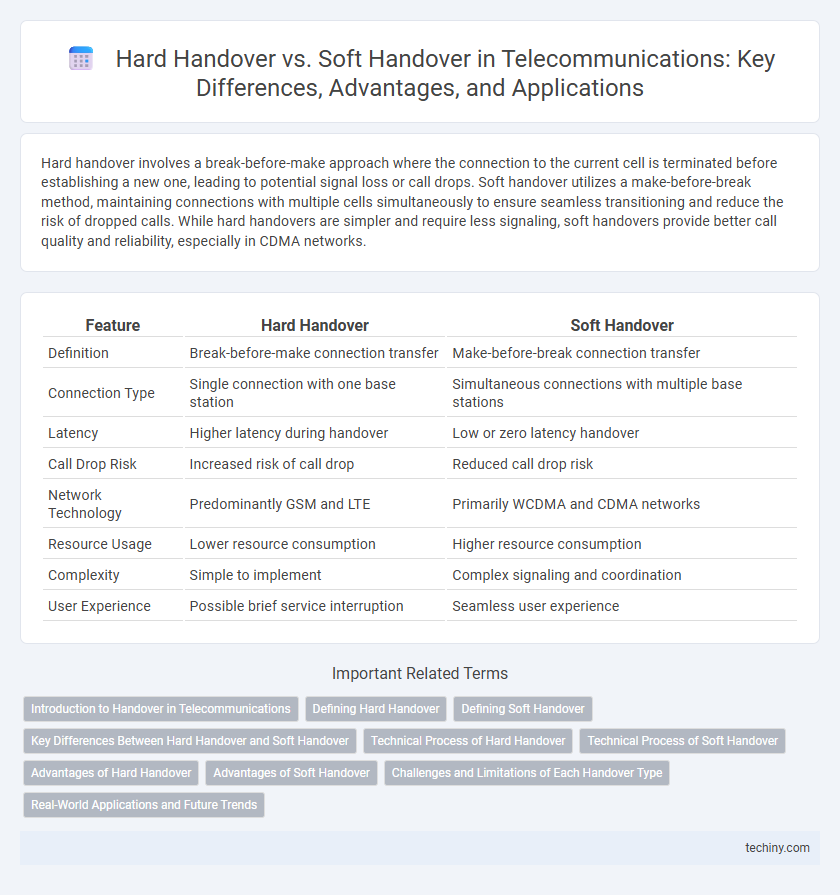Hard handover involves a break-before-make approach where the connection to the current cell is terminated before establishing a new one, leading to potential signal loss or call drops. Soft handover utilizes a make-before-break method, maintaining connections with multiple cells simultaneously to ensure seamless transitioning and reduce the risk of dropped calls. While hard handovers are simpler and require less signaling, soft handovers provide better call quality and reliability, especially in CDMA networks.
Table of Comparison
| Feature | Hard Handover | Soft Handover |
|---|---|---|
| Definition | Break-before-make connection transfer | Make-before-break connection transfer |
| Connection Type | Single connection with one base station | Simultaneous connections with multiple base stations |
| Latency | Higher latency during handover | Low or zero latency handover |
| Call Drop Risk | Increased risk of call drop | Reduced call drop risk |
| Network Technology | Predominantly GSM and LTE | Primarily WCDMA and CDMA networks |
| Resource Usage | Lower resource consumption | Higher resource consumption |
| Complexity | Simple to implement | Complex signaling and coordination |
| User Experience | Possible brief service interruption | Seamless user experience |
Introduction to Handover in Telecommunications
Handover in telecommunications ensures seamless connectivity by transferring an ongoing call or data session from one cell to another without interruption. Hard handover involves a break-before-make connection, where the current link is terminated before a new one is established, commonly used in GSM networks. Soft handover, typical in CDMA and WCDMA systems, allows simultaneous connections to multiple cells, enhancing signal quality and reducing call drops during the transition.
Defining Hard Handover
Hard handover refers to the process in cellular networks where an ongoing call or data session is abruptly transferred from one cell or base station to another without overlapping connections. This break-before-make approach involves terminating the current radio link before establishing a new one, commonly used in GSM and LTE networks. Hard handover ensures efficient spectrum usage but may cause brief interruption or call drop if the new connection is not properly established.
Defining Soft Handover
Soft handover is a process used in CDMA and WCDMA networks where a mobile device simultaneously connects to multiple base stations during a call transition, ensuring seamless communication and reduced call drops. It contrasts with hard handover, which involves a break-before-make connection, increasing the risk of temporary signal loss. Soft handover improves network reliability and call quality by allowing redundant signal paths and smoother transitions between cells.
Key Differences Between Hard Handover and Soft Handover
Hard handover involves a break-before-make connection, where the mobile device disconnects from the current cell before connecting to the new one, causing a brief interruption in service. Soft handover uses make-before-break, allowing simultaneous connections to multiple cells, enhancing signal reliability and reducing call drops in CDMA networks. The key difference lies in the connectivity approach: hard handover is typically used in GSM networks with single-cell connections, while soft handover is prevalent in CDMA systems for seamless transition and improved call quality.
Technical Process of Hard Handover
Hard handover in telecommunications involves a break-before-make process where the connection to the current base station is terminated before establishing a connection with the target base station, which can lead to a brief interruption in the call or data session. This process requires precise timing and coordination within the mobile network to avoid dropped connections, relying on signal strength measurements and network commands to trigger the handover. Hard handovers are primarily used in GSM and LTE networks where resources are allocated exclusively, unlike soft handovers that maintain simultaneous links with multiple base stations.
Technical Process of Soft Handover
Soft handover in telecommunications involves a mobile device simultaneously communicating with multiple base stations during a call transition, ensuring seamless connectivity. This process uses the CDMA or WCDMA technology's ability to combine signals from different cell sites, mitigating signal fading and reducing dropped calls. The mobile station maintains connections within a "soft handover" region until the signal from the new base station becomes dominant, optimizing call quality and network reliability.
Advantages of Hard Handover
Hard handover provides a faster and more efficient transition between cells by connecting to a new base station before disconnecting from the previous one, minimizing connection drops during high-mobility scenarios such as vehicular communication. It requires less network resource consumption compared to soft handover, as it maintains a single active link rather than multiple simultaneous connections, reducing overhead in cellular networks like LTE and 5G. Hard handover enhances system capacity by simplifying call management and decreasing interference, which is crucial for maintaining quality of service in dense urban areas.
Advantages of Soft Handover
Soft handover enhances call reliability by maintaining simultaneous connections to multiple base stations, reducing the risk of dropped calls. It enables seamless transition with minimal interference due to the use of combining techniques that improve signal quality. This method optimizes network resource utilization by balancing traffic load and minimizing retransmissions in CDMA and LTE systems.
Challenges and Limitations of Each Handover Type
Hard handover in telecommunications faces challenges such as momentary service interruption due to its break-before-make connection process, leading to potential call drops and increased latency. Soft handover, while providing smoother transitions by maintaining multiple connections simultaneously, is limited by higher resource consumption and increased complexity in network management. Both handover types struggle with maintaining seamless connectivity in high-mobility scenarios and dense urban environments where signal quality fluctuates rapidly.
Real-World Applications and Future Trends
Hard handover in telecommunications is commonly used in GSM networks where a complete break in connection occurs before establishing a new link, suitable for high-mobility scenarios such as vehicular communication. Soft handover, prevalent in CDMA and LTE networks, allows simultaneous connections to multiple base stations, enhancing call quality and reducing dropped calls in dense urban environments. Future trends indicate the integration of machine learning algorithms to optimize handover decisions dynamically, leveraging real-time network analytics for seamless user experiences in 5G and beyond.
Hard Handover vs Soft Handover Infographic

 techiny.com
techiny.com